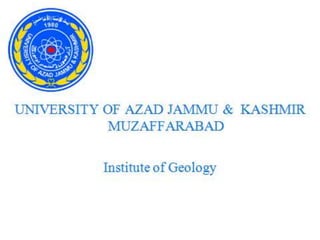
Morphological feature of foraminifera
- 1. Instituted of Geology 6th Semester (Morning) Submitted by: Khawar-u-zaman babar Roll No: 53 Submitted To: Dr.Munir Subject: Micropaleontology
- 2. Topic MORPHOLOGICAL FEATURES OF FORAMINIFERA
- 3. Morphological feature of foraminifera Kingdom: Protista Subkingdom: Protozoa Phylum: Sarcomastigophora Subphylum: Sarcodina Super class: Rhizopoda Class: Granuloreticulosea Order: Foraminiferida (foraminifera).
- 4. Introduction: The order foraminiferida or foraminifera as they are informally called forms the most important group of microfossils for two reasons: first, they are abundant in rocks and there are numerous species; second they provide valuable information in the dating of strata and the reconstruction of sedimentary environments. Foraminifera are an order of single-celled protests that live either on the sea floor or amongst the marine plankton. The soft tissue (protoplasm) of the foraminiferid cell is largely enclosed within a shell (test) variously composed of secreted minerals (calcite, aragonite or silica) or of agglutinated particles. This test consists of a single chamer or several chambers mostly less than 1 mm across and each interconnected by an opening (foramen) or several openings (foramina). Foraminifera are known from early Cambrian times through to recent times. Foraminifera are found in all marine environments, they may be planktic or benthic in mode of life. The generally accepted classification of the foraminifera is based on that of Loeblich and Tappan (1964). Unpicking this nomenclature tells us that foraminifera are testate (that is possessing a shell), protozoa, (single celled organisms characterised by the absence of tissues and organs), which possess granuloreticulose pseudopodia (these are thread-like extensions of the ectoplasm often including grains or tiny particles of various materials).
- 5. Life Cycle:
- 6. Classification Foraminifera are classified primarily on the composition and morphology of the test. Three basic wall compositions are recognised, organic (protinaceous mucopolysaccharide i.e. the allogromina), agglutinated and secreted calcium carbonate (or more rarely silica). Agglutinated forms, i.e the Textulariina, may be composed of randomly accumulated grains or grains selected on the basis of specific gravity, shape or size; some forms arrange particular grains in specific parts of the test. Secreted test foraminifera are again subdivided into three major groups, microgranular (i.e. Fusulinina), porcelaneous (i.e. Miliolina) and hyaline (i.e. Globigerinina). Microgranular walled forms (commonly found in the late Palaeozoic) are composed of equidimensional subspherical grains of crystalline calcite. Porcelaneous forms have a wall composed of thin inner and outer veneers enclosing a thick middle layer of crystallaths, they are imperforate and made from high magnesium calcite.
- 7. Test Morphology: Foraminifera are animals which build a shell; and for paleontologists the characterstics of the shell are the primary features which can be used to distinguish one species from another. Wall Structure: The most readily obvious featuredistingushing one foraminifer from another is its wall type. Whether the foraminifer builds its test wall by cementing together exogenous grains, by carbonate mineralization, or by some combination of these two processes separates the three primary foraminiferal groups, the agglutinated, the calcareous, and the microgranular foraminifera. Agglutinated wall structure In these, organic and mineral matter from the sea floor is bound together by an organic, calcareous or ferric oxide cement. The grains are commonly selected for size, texture or composition (e.g. coccoliths, sponge, spicules and heavy minerals). Other agglutinated forms are non-selective and will employ any particle from a substrate as long as it lies in the appropriate size range.
- 8. Microgranular walls Microgranular walls evolved during the Paleozoic and are considered the link between the agglutinated and the precipitated tests in foraminifera. Microgranular particles of calcite cemented by a calcareous cement characterize this wall type and give it a sugary appearance. Calcareous walls- hyaline type Calcareous wall may be composed of either low or high Mg calcite, or aragonite which is confined to only two foraminiferal families. Hyaline calcareous tests are characterized by the possession of minute perforation in the test wall. The calcareous hyaline are generally glassy (hyaline) when viewed with reflected light and grey to clear in transmitted light.
- 9. Chamber shape and chamber arrangement : Foraminiferal tests may posses one or more chambers. The initial chamber is most often spherical or oblate with an aperture. Later chambers range in shape from tubular, spherical, ovate to several others. Additional chambers are added in a variety of patterns termed chamber arrangements: 1- Uniserial: the chamber arranged in a single row; if it forms a curved row, it is termed arcute; if a straight series, it is termed rectilinear. 2- Biserial: the chambers arranged in a double row. 3- Triserial: Chambers are added every 120o in a spiral fashion. 4- Polyserial: the chambers arranged in a multiple row. 5- Planispiral: the chamber arranged spirally around an axis of coiling and the spiral lies in a single plane.
- 11. • 6- Trochospiral: when the spiral does not lie in one plane, but • progresses up up the axis of coiling, the chamber arrangement • becomes helicoidal. • 7- The Miliolidae have a streptospiral arrangement. The arched • chambers, tangential at their two extremities with the extension axis, • are arranged in cycles of five, three or two loculi or one loculus. Each • new chamber has its aperture facing the aperture of the the • preceding chamber. • When
- 13. Apertures and openings: The aperture is the primary opening of the test to the outside environment. Apertures vary in size and shape and the shape is most often a function of the shape of the chamber on which they are located. The aperture is found in the wall of the final chamber and serves to connect the external pseudopodia with the internal endoplasm, allowing passage of food and contractile vacuoles, nuclei and release of the dauther cells. Aperture may be single or multible in number and terminal, areal, basal extraumbilical, umbilical or sutural in position. Their shape varies widely, e.g. rounded, bottle-necked (phialine), radiate, dendritic, sieve-like (cribrate), circular form, slit- or loop- shaped.
